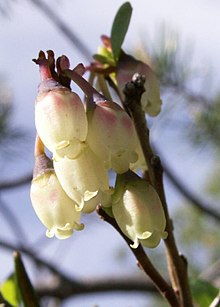Vaccinium uliginosum
| Vaccinium uliginosum | |
|---|---|

| |

| |
| Scientific classification | |
| Kingdom: | Plantae |
| Clade: | Tracheophytes |
| Clade: | Angiosperms |
| Clade: | Eudicots |
| Clade: | Asterids |
| Order: | Ericales |
| Family: | Ericaceae |
| Genus: | Vaccinium |
| Species: | V. uliginosum
|
| Binomial name | |
| Vaccinium uliginosum | |
| Synonyms[1] | |
| |
Vaccinium uliginosum (bog bilberry, bog blueberry,[2] northern bilberry or western blueberry)[3] is a Eurasian and North American flowering plant in the heath family Ericaceae.
Description
[edit]Vaccinium uliginosum is a small deciduous shrub growing to 10–75 centimetres (4–29+1⁄2 inches) tall, rarely 1 metre (3+1⁄2 feet) tall, with brown stems (unlike the green stems of the closely related bilberry). The leaves are oval, 4–30 millimetres (1⁄8–1+1⁄8 in) long and 2–15 mm (1⁄16–9⁄16 in) wide, blue-green with pale net-like veins, with a smooth margin and rounded apex.[4]
The flowers are pendulous, urn-shaped, pale pink, 4–6 mm (3⁄16–1⁄4 in) long, produced in mid spring. The fruit is a dark blue-black berry 5–8 mm (3⁄16–5⁄16 in) in diameter, with a white sweet flesh, ripe in late summer.[4] Cytology is 2n = 24.[5]
Subspecies
[edit]Three subspecies have been described, but not all authorities distinguish them:[1][4]
- Vaccinium uliginosum subsp. microphyllum Lange – Arctic plants
- Vaccinium uliginosum subsp. occidentale (A.Gray) Hultén – North American plants
- Vaccinium uliginosum subsp. uliginosum
Distribution and habitat
[edit]The plant is native to cool temperate regions of the Northern Hemisphere, at low altitudes in the Arctic, Baltics, and at high altitudes south to the Pyrenees, the Alps, and the Caucasus in Europe, the mountains of Mongolia, northern China, the Korean Peninsula and central Japan in Asia, and the Sierra Nevada in California and the Rocky Mountains in Utah in North America.[4][6][7][8]
It grows on wet acidic soils on heathland, moorland, tundra, and in the understory of coniferous forests, from sea level in the Arctic, up to 3,400 m (11,200 ft) altitude in the south of the range.
V. uliginosum can survive long, severe climatic oscillations.[9][10]
Uses
[edit]The berries can be eaten raw or cooked, used to make jelly or pies, or dried to make pemmican.[11]
In Korean cuisine, bog bilberry is used to make infused liquor (Deuljjuk-sul).
-
Bilberries on branches
-
Close-up of bilberries in Eastern Siberia
-
Bog bilberry liquor (left) produced in North Korea
References
[edit]- ^ a b "Vaccinium uliginosum". World Checklist of Selected Plant Families. Royal Botanic Gardens, Kew – via The Plant List. Note that this website has been superseded by World Flora Online
- ^ USDA, NRCS (n.d.). "Vaccinium uliginosum". The PLANTS Database (plants.usda.gov). Greensboro, North Carolina: National Plant Data Team. Retrieved 28 July 2015.
- ^ Wallace, Gary D. (2017). "Vaccinium uliginosum subsp. occidentale". In Jepson Flora Project (ed.). Jepson eFlora. The Jepson Herbarium, University of California, Berkeley. Retrieved 18 July 2018.
- ^ a b c d Vander Kloet, Sam P. (2009). "Vaccinium uliginosum". In Flora of North America Editorial Committee (ed.). Flora of North America North of Mexico (FNA). Vol. 8. New York and Oxford: Oxford University Press – via eFloras.org, Missouri Botanical Garden, St. Louis, MO & Harvard University Herbaria, Cambridge, MA.
- ^ Redpath, Lauren E.; Aryal, Rishi; Lynch, Nathan; Spencer, Jessica A.; Hulse-Kemp, Amanda M.; Ballington, James R.; Green, Jaimie; Bassil, Nahla; Hummer, Kim; Ranney, Thomas; Ashrafi, Hamid (2022). "Nuclear DNA contents and ploidy levels of North American Vaccinium species and interspecific hybrids". Scientia Horticulturae. 297. Elsevier BV: 110955. doi:10.1016/j.scienta.2022.110955. ISSN 0304-4238.
- ^ Fang, Ruizheng; Steven, Peter F. "Vaccinium uliginosum". Flora of China. Vol. 14 – via eFloras.org, Missouri Botanical Garden, St. Louis, MO & Harvard University Herbaria, Cambridge, MA.
- ^ Altervista Flora Italiana, Falso mirtillo, Vaccinium uliginosum L.
- ^ "Vaccinium uliginosum". State-level distribution map from the North American Plant Atlas (NAPA). Biota of North America Program (BONAP). 2014.
- ^ Alexander, Jake M.; Chalmandrier, Loïc; Lenoir, Jonathan; et al. (2017-11-27). "Lags in the response of mountain plant communities to climate change". Global Change Biology. 24 (2): 563–579. doi:10.1111/gcb.13976. ISSN 1354-1013. PMC 5813787. PMID 29112781.
- ^ De Witte, LC; Armbruster, GFJ; Gielly, L; Taberlet, P; Stocklin, J (2011-11-10). "AFLP markers reveal high clonal diversity and extreme longevity in four key arctic‐alpine species". Molecular Ecology. 21 (5): 1081–1097. doi:10.1111/j.1365-294x.2011.05326.x. ISSN 0962-1083. PMID 22070158.
- ^ Nyerges, Christopher (2017). Foraging Washington: Finding, Identifying, and Preparing Edible Wild Foods. Guilford, CT: Falcon Guides. ISBN 978-1-4930-2534-3. OCLC 965922681.
Further reading
[edit]- Blamey, M.; Grey-Wilson, C. (1989). Flora of Britain and Northern Europe. Hodder & Stoughton.
External links
[edit]- Calflora
- Jepson Manual treatment of Vaccinium uliginosum – flora of California.
- Flora Europaea: Vaccinium uliginosum
- Plants of British Columbia: Vaccinium uliginosum
- Vaccinium uliginosum in the CalPhotos photo database, University of California, Berkeley
 Media related to Vaccinium uliginosum at Wikimedia Commons
Media related to Vaccinium uliginosum at Wikimedia Commons
- Vaccinium
- Berries
- Alpine flora
- Flora of the Arctic
- Flora of the Alps
- Flora of Europe
- Flora of temperate Asia
- Flora of Canada
- Flora of Greenland
- Flora of the Northeastern United States
- Flora of the Western United States
- Flora of the Sierra Nevada (United States)
- Bird food plants
- Japanese fruit
- Plants described in 1753
- Taxa named by Carl Linnaeus



